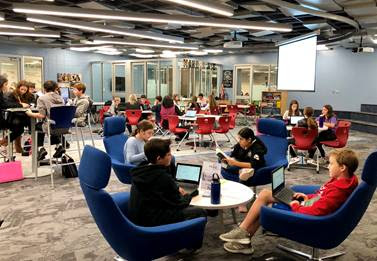Design Studies Assignment: Learning Commons Modernization
Libraries are no longer simply a location to collect and organize print resources. They have become an integral part of a school’s learning culture.
The new library model provides a place for students to collaborate, enjoy fellowship, engage in interactive learning, create and challenge ideas, and experience learning and discovery in a multitude of ways.
Today’s libraries serve four key functions, in addition to their traditional role of housing printed materials.
First, they are a locus for collaboration. As pedagogy shifts and learning becomes more team oriented and less individualistic, there is a new demand for collaboration space for students. Having a place to come together is critical to student success and the full utilization of the library as a learning space.
To utilize our library to its fullest capacity we need to plan for and anticipate the needs of two or three classes or varying groups of students working in the library at the same time. The space also needs to be suitable for parent and community meetings and forums.
Second, while providing collaborative space is critical, there is also a need for individual, contemplative space. This includes a variety of spaces to suit the individual needs and learning styles of today’s students. Private, traditional workspaces suit some students, while comfortable lounge furniture are ideal for others. A blend of formal and informal spaces can create environments where all students can have their needs met.
A third function of the library is to provide a home for resources, such as reading and writing centers/collections, materials and other specialty items.
And last, libraries must continue to provide both traditional research and technical services while also providing the latest in computer technology and associated technology support services.
With the four key functions of collaboration, individual spaces, resource storage, and technology needs in mind, we are looking at key design fundamentals to support learning and ensure optimum capacity.
These include:
Flexibility
Library design today must also look to the future. The best way to do this is to maximize flexibility in spaces and infrastructure. Building core infrastructure such as shelving, storage, use of natural lighting, modular furnishings will support future renovation and ensure a smoother transition as new needs surface.
Short-term flexibility is also important. Movable furniture and temporary shelving partitions serve not only the long-term function of space but also short-term needs for flexible work environments.
When students are allowed to reconfigure their work environment, they will find ways to create the most conducive environment for collaboration and optimal learning.
Belonging
Learners should feel like the space is theirs. Students need to be inspired by the visual displays and have access to multiple resources.
Neat
Supplies, tools, furniture and books should be stored, have a designated space as well as be easily accessible. Consideration must be given to the storage and materials. An organization that is tidy and visually uncluttered, eliminates distraction and promotes student self- regulation.
Concentration
Air quality, temperature, lighting, and sound are linked to student behaviours and academic performance. Sound-absorbing materials help students to focus. Lighting impacts cognition. Consideration must be prioritized for infrastructure elements that support student focus.
Functional
Technology is key to learning environments. Space design will need to include charging stations, multiple spaces for device use, designated space for device storage, drop projector consideration for large group presentations.
With classical library reference and research resources and a blend of computer and technology services, the library is the heart and soul of the school. It serves as a hub for students to gather, exchange ideas, collaborate, and utilize multiple technologies.
Our work has begun. Book collections have been sorted, resource collections reviewed, and space decluttered. Infrastructure review including carpeting, shelving, display areas, window coverings and resource replacement including technology updates, flexible workspaces and seating are all under review.
Further reading links:
Modernization ideas: https://blog.schoolspecialty.com/when-designing-a-modern-school-library-here-are-some-ideas-to-inspire-you/


Comments
Post a Comment